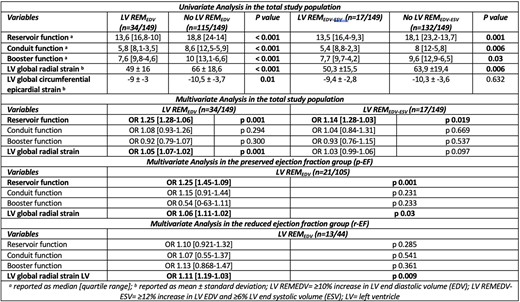-
PDF
- Split View
-
Views
-
Cite
Cite
A Attanasio, L Tondi, S Castelvecchio, A Camporeale, G Disabato, G Guida, M Lombardi, P G Camici, Prognostic role of left atrial morpho-functional parameters in left ventricular remodeling following acute st-elevation myocardial infarction, European Heart Journal - Cardiovascular Imaging, Volume 24, Issue Supplement_1, June 2023, jead119.122, https://doi.org/10.1093/ehjci/jead119.122
Close - Share Icon Share
Abstract
Type of funding sources: None.
Despite prompt reperfusion and optimal medical therapy of acute ST-elevation myocardial infarction (STEMI), patients may undergo left ventricular (LV) remodeling (REM), which may lead to systolic and/or diastolic heart failure. Little is known regarding factors and mechanisms leading to LV REM, and this knowledge gap hinders potential strategies to prevent this complication. Left atrium (LA) functional and dimensional parameters are emerging as independent prognostic markers in ischemic heart disease.
The present study aims at exploring the potential role of LA morpho-functional parameters by CMR-FT in predicting LV REM following STEMI.
This study derives from a sub-analysis of the prospective and multicenter "VavirimS" trial. All patients were assessed through 2 consecutive CMR scans, at 1 and 6 months after STEMI. CMR-FT was applied to both LA and LV. The endpoint was to evaluate the association between LA volumes and phasic functions with LV REM at 6-month follow up, defined as: i) LV REMEDV: ≥10% increase in LV end diastolic volume (EDV); ii) LV REMEDV-ESV: ≥12% increase in LV EDV and ≥6% LV end systolic volume (ESV).
Out of 193 patients included in the VavirimS trial, 149 were enrolled and 44 have been excluded either for inadequate image quality for CMR-FT analysis or for the presence of factors impacting on LA morphology and function (i.e. mitral regurgitation and atrial fibrillation). LV REMEDV occurred in 34 patients (23%), who showed worse LA strain parameters (reservoir, conduit and booster function), LV global radial strain (GRS) and LV global circumferential epicardial strain [Fig. 1]. At multivariate analysis, LA reservoir and LV global radial strain (GRS) were confirmed as independent predictors of LV-REMEDV [Fig. 1]. The best cut-off for LA reservoir and LV GRS were 20% (sensitivity 97%; specificity 45%) and 56% (sensitivity 67%; specificity 69%), respectively. LV REMEDV-ESV occurred in 17 patients (11%), who showed reduced LA strain and LV GRS [Fig. 1]. The only independent predictor of LV remodeling in this group was LA reservoir [Fig. 1]. A subgroup analysis has been performed on two groups, according to EF: i) p-EF: preserved ejection fraction, ii) r-EF: reduced ejection fraction. In the p-EF group both LA reservoir and LV GRS were confirmed to be associated with LV REM [Fig. 1], while in the r-EF group the only independent predictor of LV REM was LV GRS [Fig. 1].
CMR-derived LA reservoir and LV GRS are independent predictors of LV remodeling following STEMI. In patients with preserved EF LA reservoir is confirmed as independent predictor of LV remodeling, hinting at early and subclinical impairment of left chambers compliance. LA functional parameters following STEMI may help physicians in identifying patients at higher risk of LV remodeling.

Univariate and multivariate analysis

Left atrial strain curves
- atrial fibrillation
- st segment elevation myocardial infarction
- myocardial ischemia
- mitral valve insufficiency
- heart failure, diastolic
- left ventricular remodeling
- left atrium
- ventricular end-systolic volume
- conduit implant
- left ventricle
- reperfusion therapy
- physiologic reperfusion
- diastole
- follow-up
- systole
- patient prognosis
- ejection fraction
- cardiac mri
- prognostic marker
- image quality
- radial strain
- medical management



